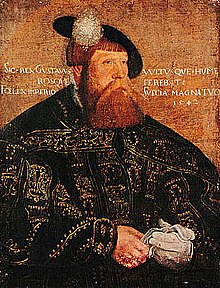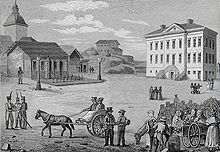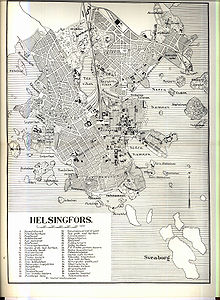History of Helsinki
The history of Helsinki , the capital of Finland , dates back to the 12th century. After prolonged periods of Swedish and Russian influence, the capital region expanded to become the most populous region in all of Finland.
Swedish beginnings
Under the rule of Sweden, Uusimaa (Swedish. Nyland) was taken over by Swedish new settlers in the early Middle Ages . Previously, the inhabitants of the Häme region inland and Estonians on the other side of the Finnish bay had used the area as a hunting ground without settling there permanently. The landscape in which Helsinki is located today has been inhabited by Swedish-speaking people since the Middle Ages. The most prominent memory of this time is the castle hill in Vartiokylänlahti . King Gustav Vasa founded Helsinki at the mouth of the Vantaa River in what is now Arabiaranta on June 12, 1550.
First and foremost, this was done for political reasons in order to be able to keep up economically with Reval (today's Tallinn ) on the other side of the bay . The name Helsinki is probably derived from the Swedish landscape of Hälsingland , from which the city's new settlers came. The city's first residents also came from nearby Porvoo , Ekenäs [Tammisaari] and Rauma . The urban bourgeoisie of Ulvsby was ordered to move to the new town. The settlers were resettled partly by conviction and partly by overt violence in order to build a sufficient population base for the new city. The area in which this early settlement of Helsinki was located is still called Vanhakaupunki ("old town"), although nothing of the original city has survived.
The city received various basic food privileges by decree on August 3, 1569 and was intended to improve trade with Russia . However, the city's growth did not initially develop as desired by the Swedish krona, and the shallow depth of the offshore bay also caused problems in connecting the city to the sea routes used.

When Swedish troops conquered northern Estonia and Reval in the Livonian War in 1561 , the original intention of establishing Helsinki as a Swedish base and rival of the city of Reval lost its importance. In the Baltic Sea region, however, the city retained some importance as a military base. It offered the army and fleet a place for loading and wintering.
Resettlement of the city
Since the original settlement was in the rocky bay of the mouth of the Vantaa River, it was difficult to find a landing site for large sailing ships. There were plans early on to move the city closer to the open sea. The original plan was to relocate Helsinki in the Santahamina area or what is now Sörnäinen, but shortly before implementation it was determined that there would have been too little potential for the city to grow further. Finally, in 1640, under the direction of Governor General Per Brahe, the city was relocated to the newly elected Vironniemi ( Estnäs in Swedish ).
Today this part of the city is in the Kruununhaka district, on Senate Square. The previously populated city at the mouth of the Vantaa River remained deserted from that date. The map of Helsinki from 1645 shows both the old settlement on the Vantaa River and that of the new Helsinki in their current position. The city received new privileges under Queen Christina (in a royal letter of January 17, 1651). These also included new weapons for defense.
With the relocation of the city, a better location was achieved with two spacious harbors protected by nature. However, the population was repeatedly tormented by fires, famine, plague and the dangers of war. Also due to the repeated flight from approaching enemy troops, the city did not develop continuously.
The Northern War
The Great Northern War was associated with great hardship for the city. In 1710, the city was ravaged by the plague that killed two thirds of the city's residents - 1,185 people in four months. In 1713, its own army burned the city of Helsinki to prevent the advancing enemy from using it to their advantage. Eventually the Russian troops occupied the abandoned city and stayed there from 1713–1721. The area was abandoned by troops in 1721 when the Peace of Nystad ended the Great Northern War. After the war, the city of Helsinki began to be rebuilt according to the old city map. However, the further development of the city remained difficult for a long time.
During the next armed conflict with the Russian Empire in the years 1742–1743, the city of Helsinki was occupied again, but this time the buildings remained largely intact. Since the Swedish Empire had lost large areas, fortified border castles were built after 1743 in Hamina on the mainland and the Viaporin fortress on an island off Helsinki. The new Swedish sea fortress Sveaborg that was built there was established by the officer Augustin Ehrensvärd . The execution of this major project also led to a positive population development in Helsinki and an economic boom through the establishment of several brickworks and mansions on the mainland.
With the conflict between Napoleon and Tsar Alexander I of Russia, the Russo-Swedish War broke out in 1808. Russian troops conquered Helsinki again in 1808. During the siege of the city, fire destroyed almost the entire city. Even so, Helsinki became one of the most populous cities in the country. In 1805 the city only had an area of 40 hectares and a population of 4,237 people. In 1830, however, that population had grown to 11,100 people, and by the turn of the century there were already 93,600 people living in the city. At around the same time, the city's linguistic environment also changed. Due to the large migration of Finnish speakers to Helsinki, Swedish became a minority language, even though the city's elite continued to use the language.
Russian influence and development to the capital
Provincial Governor Gustav Fredrik Stjernvall had submitted the proposal in 1810 to move the capital from Turku to Helsinki. The proposal included the expansion of the Viaporin Fortress, and finally, in 1812, 4,000 people who had previously resided in Turku moved to Helsinki.
After the lost Swedish-Russian War, Sweden had to cede all of Finland to Russia in 1809. The Tsar of Russia and the new Grand Duke of Finland, Alexander I, wanted the capital of Finland to be located closer to St. Petersburg and further away from Sweden, which is why he decided on April 8, 1812 by decree Helsinki to be the new capital.
At the same time, Carl Ludwig Engel was chosen to redesign the center of Helsinki after the city fire and to give the city a representative appearance. Johan Albrecht Ehrenström, who drew up the new plan for the city of Helsinki, was also involved in the urban planning of this period. Many of the neoclassical buildings in Helsinki, especially around Senate Square, and the cathedral, which can be seen from afar, were designed by Engel. The surrounding districts consisted of mostly one-story wooden houses, of which only a few buildings are preserved today. Helsinki had been the seat of the Finnish Senate since 1819, making it the final capital of the Grand Duchy. In many parts of the city the street scene changed due to a large number of Art Nouveau buildings that were built in the period that followed, especially in the districts of Katajanokka , Kruununhaka and Eira.
After the Great Fire of Turku in 1827, the Turku Academy , then the only university in Finland, was moved to Helsinki and converted into the University of Helsinki in 1828 . For the first time, a university has now also been established in the new capital. From then on Helsinki became an administrative, university and garrison city, and subsequently also a real industrial center. Important rail connections ran through Hämeenlinna from 1862 and to St. Petersburg from 1870. At the end of the century in 1900, the population exceeded 100,000 for the first time.
The urban development of Helsinki from 1900
Around the turn of the century, a number of houses were built in the hinterland of the Pitkäsilta Bridge in which workers lived in small apartments for a long time. In the vicinity of the Linnanmäki amusement park, many working-class families also lived in wooden houses. At the beginning of the 20th century, larger apartments for workers were built in Kristiinankatu by the City of Helsinki in order to create better living conditions for working class families.
At that time, these apartments were rented out to particularly large families, whose head of household had been in the service of the city for a long time for not exactly low rents. However, the wooden houses in the Kallio district fell victim to the wrecking ball from the 1950s onwards.
Helsinki became the capital of the independent Republic of Finland with the declaration of independence on December 6, 1917. However, the Finnish civil war began as early as the next month, on January 27, 1918, when revolutionary troops gathered in the working-class district of Hakaniemi . Red Guards soon invaded the city and the government Senate was forced to be evacuated to Vaasa .
In April, German troops intervened in support of the White Guards and conquered Helsinki after fighting on April 13, 1918. With the support of German troops under General Rüdiger von der Goltz , the Finnish army under Mannerheim won Helsinki back. After the war, which had been decided in favor of the bourgeois whites, around 10,000 members of the Red Army were interned on the island of Suomenlinna , of which around 1,500 died of starvation or disease. After the civil war, the Viaporin sea fortress served as a prisoner of war camp. In 1918 the name of the fortress in front of Helsinki was changed to "Suomenlinna". Unlike in the Finnish city of Tampere , the civil war in Helsinki did relatively little damage.
Many of the suburbs were integrated into the urban area in the 1920s, and some of them formed a separate rural municipality of Helsinki . These were the communities of Huopalahti , Haaga, Kulosaari and Oulunkylä . This was short-lived, however, as in 1946 these were all linked to Helsinki. At the beginning of the century, the Helsinki area was limited to the Helsinginniemi peninsula . This urban area is known today as the core city ( kantakaupunki ). The city was surrounded by the area of the rural municipality Helsinki (Helsingin maalaiskunta), the remains of which form today's Vantaa. Over time, parts of the rural community were repeatedly incorporated into the city of Helsinki: in 1906 the districts of Meilahti , Käpylä and Kumpula , in 1912 Pasila , in 1926 Ruskeasuo and Uusipelto .
The second World War
The city was bombed several times during the Second World War. However, there was no major destruction. In addition, Helsinki was one of the few capitals besides London and Moscow in Europe that was not conquered.
However, with the end of the war there was an emergency in the city, also because the city had to accept a large number of refugees from Karelia and Porkkala .
the post war period
Helsinki was supposed to host the Summer Olympics in 1940, but that plan was not implemented because of World War II. In the subsequent planning of the Olympic Games in the post-war period, a lot of functionalist architecture was built in the city. The Olympic Stadium, the Tennis Palace, the Olympic Village and the Glass Palace all date from this period. In 1952 the Olympic Games could then take place in Helsinki.
Further incorporations were carried out in 1946 when 14 districts from the rural parish were merged with the city of Helsinki. At the same time, the then independent communities Haaga, Huopalathi, Kulosaari and Oulunkylä were incorporated into the city of Helsinki. In 1966 the city acquired Vuosaari as another district.
Further growth
In 1975 the Finlandia Hall hosted the first Conference on Security and Cooperation in Europe (CSCE). 35 heads of state attended the conference. In the meeting the limits of the post-war period were confirmed.
The city grew at a record pace during the 1960 / 1970s. In order to cope with the urban planning challenges associated with the growing population, various infrastructural measures such as expansion and construction of new residential areas, expansion of roads and bypasses were implemented.
In addition, the tram network of the city of Helsinki was preserved and further expanded and modernized. The ports were expanded into large overseas ports. Some of the archipelago islands off the mainland were integrated into large-scale land reclamation measures that changed the original appearance of the ports. In August 1982 a metro was opened in Helsinki.
At the beginning of 2009 the urban region of Helsinki expanded again when 2,660 hectares were brought from the western part of Sipoo and around 200 hectares from the city of Vantaa to Helsinki. The city decided on June 21, 2006 to propose this integration to the State Council. The government decided to annex it on June 28, 2007 . The Supreme Administrative Court had initially rejected it, but the incorporation of the areas came into force on January 1, 2009.
In 2008 Helsinki's cargo port moved from Länsisatama (western port ) , which is close to the city center, to Vuosaari in East Helsinki. This relocation has triggered a new building boom, as large new areas are now available near the city center. By 2030, new districts near the sea with apartments for approx. 44,000 residents will be built in the old port and industrial areas in Jätkäsaari, Kalasatama and Kruunuvuorenranta.
Helsinki was originally home to an almost entirely Swedish-speaking upper class . However, this picture changed due to the migration of the rural population over the centuries. Around 1890, for the first time, the proportion of Finnish-speaking people was greater than that of the Swedish-speaking urban population. In 2000 this proportion fell to 7.8% of the Swedish-speaking population, a proportion that is expected to continue to decline.
literature
- Arvi Ilonen: Helsinki: An Architectural Guide. Otava, Helsinki 1990, ISBN 951-1-10762-3 .
- Neil Kent: Helsinki: A Cultural and Literary History. Signal Books, Oxford 2004, ISBN 1-902669-75-4 .
- Heikki Mäntymäki, Teresia Liljelund: Urban planning considerations Helsinki. Helsingin kaupungin kaupunkisuunnitteluvirasto / City Planning Office, Helsinki 2008, ISBN 978-952-223-054-6 .
- Zetterberg, Seppo & Kallio, Veikko: Suomen historian Pikkujättiläinen. Porvoo, Helsinki, Juva: WSOY, 1987, p. 388. ISBN 951-0-14253-0 .
Web links
- Helsinki City Museum (also in German)
- City website (also in German)
- Historical Atlas Helsinki
- Historical Helsinki
- Histdoc
- History of Helsinki
Individual evidence
- ^ Zetterberg, Seppo & Kallio, Veikko, Suomen historian Pikkujättiläinen, WSOY: Porvoo, Helsinki, Juva, 1987, p. 388. ISBN 951-0-14253-0
- ↑ Nikkemedian taidehistoria: Archive link ( Memento of the original from March 5, 2016 in the Internet Archive ) Info: The archive link was inserted automatically and has not yet been checked. Please check the original and archive link according to the instructions and then remove this notice.
- ↑ 1812–2012 - Helsinki 200 years as capital: Archived copy ( Memento of the original from September 19, 2013 in the Internet Archive ) Info: The archive link has been inserted automatically and has not yet been checked. Please check the original and archive link according to the instructions and then remove this notice.
- ↑ Helsinki City Museum: Archive link ( Memento of the original dated May 3, 2015 in the Internet Archive ) Info: The archive link was inserted automatically and has not yet been checked. Please check the original and archive link according to the instructions and then remove this notice.
- ↑ YLE: [1]
- ↑ KHO: [2]
- ↑ City of Helsinki: Archive link ( memento of the original from September 24, 2015 in the Internet Archive ) Info: The archive link was inserted automatically and has not yet been checked. Please check the original and archive link according to the instructions and then remove this notice.










